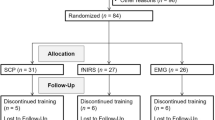Abstract
Eighteen children with ADD/ADHD, some of whom were also LD, ranging in ages from 5 through 15 were randomly assigned to one of two conditions. The experimental condition consisted of 40 45-minute sessions of training in enhancing beta activity and suppressing theta activity, spaced over 6 months. The control condition, waiting list group, received no EEG biofeedback. No other psychological treatment or medication was administered to any subjects. All subjects were measured at pretreatment and at posttreatment on an IQ test and parent behavior rating scales for inattention, hyperactivity, and aggressive/defiant (oppositional) behaviors. At posttreatment the experimental group demonstrated a significant increase (mean of 9 points) on the K-Bit IQ Composite as compared to the control group (p<.05). The experimental group also significantly reduced inattentive behaviors as rated by parents (p<.05). The significant improvements in intellectual functioning and attentive behaviors might be explained as a result of the attentional enhancement affected by EEG biofeedback training. Further research utilizing improved data collection and analysis, more stringent control groups, and larger sample sizes are needed to support and replicate these findings.
Similar content being viewed by others
References
American Psychiatric Association (1980).Diagnostic and statistical manual of mental disorders (3rd ed.). Washington, DC: Author.
American Psychiatric Association (1987).Diagnostic and statistical manual of mental disorders (3rd ed. rev.). Washington, DC: Author.
Atkins, M., & Milich, R. (1987). IOWA-Conners Teacher Rating Scale. In M. Hersen & A. Bellack (Eds.),Dictionary of behavioral assessment techniques (pp. 273–275). New York: Pergamon.
Barkley, R. A. (1990).Attention deficit hyperactivity disorder: A handbook for diagnosis and treatment. New York: Guilford.
Kaufman, A., & Kaufman, N. (1990).K.BIT: Kaufman Brief Intelligence Manual. Circle Pines, MN: American Guidance Service.
Kirk, R. E. (1968).Experimental design: Procedures for the behavioral sciences. Belmont, CA: Brooks/Cole.
Lambert, N., Hartsough, C., Sassone, D., & Sandoval, J. (1987). persistence of hyperactivity symptoms from childhood to adulthood.American Journal of Orthopsychiatry, 57, 22–32.
Linden, M. (1988)An auditory event related potential evaluation of subgroups of hyperactive children to assess underlying arousal level. Unpublished doctoral dissertation, California School of Professional Psychology, San Diego.
Linden, M. (1991). Event related potentials of subgroups of attention deficit disorder children and implications for EEG biofeedback.California Biofeedback, 7, 7–12.
Lubar, J. (1991). Discourse on the development of EEG diagnostics and biofeedback for attention-deficit/hyperactivity disorders.Biofeedback and Self-Regulation, 16, 201–225.
Lubar, J. (1992). Address delivered to CHADD, Chicago, IL, October 14, 1992.
Lubar, J., Bianchini, K., Calhoun, W., Lambert, E., Brody, Z. & Shabsin, H. (1985). Spectral analysis of EEG differences between children with and without learning disabilities.Journal of Learning Disabilities, 18, 403–408.
Lubar, J., & Lubar, J. (1984). Electroencephalographic biofeedback of SMR and beta for treatment of attention deficit disorders in a clinical setting.Biofeedback and Self-Regulation, 9, 1–23.
Lubar, J., & Shouse, M. (1976). EEG and behavioral changes in a hyperactive child concurrent with training of the sensorimotor rhythm (SMR). A preliminary report.Biofeedback and Self-Regulation, 1, 293–306.
Milich, R., & Fitzgerald, G. (1985). A validation of inattention/overactivity and aggressive ratings with classroom observations.Journal of Consulting and Clinical Psychology, 53, 139–140.
Milich, R., Loney, J., & Landau, S. (1982). Independent dimensions of hyperactivity and aggression: A validation with playroom observation data.Journal of Abnormal Psychology, 91, 183–198.
Muehl, S., Knott, J., & Benton, A. (1965). EEG abnormality and psychological test performanced in reading disability.Cortex, 1, 434–439.
Nall, A. (1973). Alpha training and the hyperactive child: Is it effective?Academic Therapy, 9, 5–19.
Satterfield, J. (1973). EEG issues in children with minimal brain dysfunction.Seminars in Psychiatry, 5, 35–46.
Satterfield, J., & Braley, B. (1977). Evoked potentials and brain maturation in hyperactive and normal children.EEG and Clinical Neurophysiology, 43, 43–51.
Swanson, J., Nolan, W., & Pelham, W. (1981). The SNAP rating scale.Resources in Education.
Tansey, M. (1984). EEG sensorimotor rhythm biofeedback training: Some effects on the neurologic precursors of learning disabilities.International Journal of Psychophysiology, 1, 163–177.
Tansey, M. (1985). Brainwave signatures—An index reflective of the brain's functional neuroanatomy: Further findings on the effects of EEG SMR biofeedback training on the neurologic precursors of learning disabilities.International Journal of Psychophysiology, 3, 85–89.
Tansey, M. (1990). Righting the rhythms of reason: EEG biofeedback training as a therapeutic modality in a clinical office setting.Medical Psychotherapy, 3, 57–68.
Tansey, M. (1991). Wechsler (WISC-R) changes following treatment of learning disabilities via EEG biofeedback training in a private practice setting.Australian Journal of Psychology, 43, 147–153.
Tansey, M., & Bruner, R. (1983). EMG and EEG biofeedback training in the treatment of a 10-year old hyperactive boy with a developmental reading disorder.Biofeedback and Self-Regulation, 8, 25–37.
Winkler, A., Dixon, J., & Parker, J. (1970). Brain function in problem children and controls: Psychometric, neurological, electroencephalogic comparisons.American Journal of Psychiatry, 127, 94–105.
Zametkin, A., Nordal, T., Gross, M., King, A., Semple, W., Rumsey, J., Hamburger, S., & Cohen, R. (1990). Cerebral glucose in adults with hyperactivity of childhood onset.New England Journal of Medicine, 323, 1361–1366.
Author information
Authors and Affiliations
Rights and permissions
About this article
Cite this article
Linden, M., Habib, T. & Radojevic, V. A controlled study of the effects of EEG biofeedback on cognition and behavior of children with attention deficit disorder and learning disabilities. Biofeedback and Self-Regulation 21, 35–49 (1996). https://doi.org/10.1007/BF02214148
Issue Date:
DOI: https://doi.org/10.1007/BF02214148




